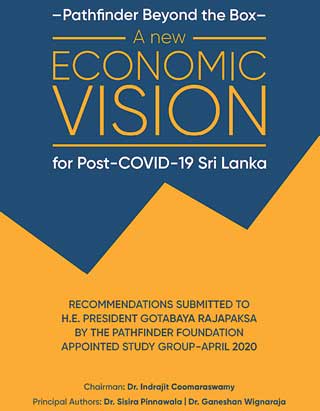Tuesday Dec 23, 2025
Tuesday Dec 23, 2025
Tuesday, 29 June 2021 01:16 - - {{hitsCtrl.values.hits}}
 The Pathfinder Foundation produced a report titled ‘Pathfinder Beyond the Box; a New Economic Vision for post-COVID Sri Lanka’ and the full text is available via https://bit.ly/3iSRx1L. The report was presented to senior policymakers and made available to the public in May 2020. Fourteen months on, it is time to take stock.
The Pathfinder Foundation produced a report titled ‘Pathfinder Beyond the Box; a New Economic Vision for post-COVID Sri Lanka’ and the full text is available via https://bit.ly/3iSRx1L. The report was presented to senior policymakers and made available to the public in May 2020. Fourteen months on, it is time to take stock.
The report presented a policy matrix which identified issues and actions in the following areas: Social Empowerment and Safety Nets: Food Security and Agriculture; Macro-Economic Management; Trade and Investment; Infrastructure; Technology; Labour; Finance; and Policy Coordination.
Some of the recommendations in the report seem aligned with Government policy. However, the Pathfinder Foundation is of the view that there are other recommendations in the report which merit consideration at this point.
COVID-19 and its impact
Sri Lanka, like many countries, has been severely affected by both the medical and the economic consequences of the pandemic. The economic impact has been greatly amplified by the fact that the country entered the crisis with twin deficits (in the budget and in the current account of the balance of payments).
This has placed Sri Lanka in a category alongside the most vulnerable countries, with very limited buffers to absorb the effects of external and/or domestic shocks – a predicament which is the result of very many years where politics consistently overwhelmed basic economic principles, particularly in relation to fiscal policy and exchange rate management.
The third wave of the pandemic is posing more demanding health challenges. In addition, the economy has been brought to a precarious state. Disruption to economic activities has dealt a blow to the growth momentum. This is being compounded by severe dollar illiquidity. Inflation, particularly food inflation, is being elevated by supply constraints caused, inter alia, by import restrictions and the ban on chemical fertilisers and pesticides. When inflation is caused by supply constraints, it tends to be transitory, unless it persists to the point where it affects inflationary expectations.
On the external front, gross official reserves have declined to the point where questions can be raised as to whether the country’s external debt servicing can be met while sustaining a level of imports which would meet the demand for essentials, like food and pharmaceuticals, as well as intermediate and investment goods required to support growth, employment and incomes.
Time for a policy reset?
Has the time come to consider whether the current policy stance should be reviewed? It includes, inter alia, yield-curve management in monetary policy; control of the exchange rate through moral suasion and administrative measures, including import restrictions; a low-tax regime at a time when it is proving to be problematic to get government revenue above 10% of GDP (peer countries collect 20% of GDP) while expenditure amounts to 19% -/20% of GDP; a reliance on SWAPs (bilateral Government arrangements as well as expensive arrangements with private parties) which tend to be short term in nature and can contribute to elevating rather than containing rollover risk.
The effect of the combination of decades of weak economic management and the unprecedented adverse impact of the pandemic means that Sri Lanka does not have any easy options. Managing the crisis with as little pain as possible needs to be the priority.
The immediate priority is stabilising the economy by: 1. Restoring fiscal sustainability in the medium term, primarily through revenue enhancement, and 2. Restoring debt sustainability by reprofiling debt servicing to a level which avoids severe compression of domestic absorption (investment plus consumption).
Choosing the least painful path
If the priority is to limit the pain of the adjustment required to stabilise the economy and place it on a path of sustained growth and development, an arrangement with the IMF can facilitate a less painful blend of financing and adjustment. It can increase confidence among creditors and investors, which in turn would address the current dollar illiquidity by unlocking a more diverse range of bilateral, multilateral and market-based financing sources. Pain cannot be avoided. The challenge is to choose the least painful path.